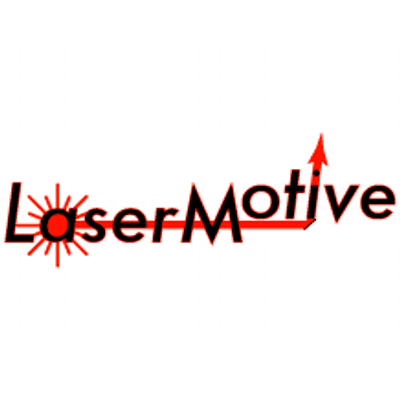Genre Lasers Headquarters Kent Founders Tom Nugent, Jordin Kare | Website lasermotive.com Type of business Engineering | |
 | ||
Lasermotive who we are and what is power beaming
LaserMotive is a U.S. engineering firm developing technologies for efficiently transmitting power via lasers, a form of wireless energy transfer commonly called "laser power beaming".
Contents
- Lasermotive who we are and what is power beaming
- Spie 2013 lasermotive demos laser powered uav flight
- History
- Technology
- Applications
- Tether propulsion
- Aircraft propulsion
- References
Spie 2013 lasermotive demos laser powered uav flight
History
LaserMotive was founded in 2006 by physicists Tom Nugent and Jordin Kare. The company's initial goal was to win the NASA Centennial Challenges Power Beam challenge. After winning the challenge, LaserMotive focused on developing the power beaming technology for commercial application on UAVs.
Technology
The power beaming system uses a laser running from a power supply. To define the beam size at its destination, the laser's light can be shaped by a set of optics. This light energy can be sent through air or the vacuum of space, onto a photovoltaic (PV) receiver, where it is converted back into electricity.
In addition to delivering energy through air or space, LaserMotive has adapted the technology to deliver over 10 watts of electricity through an optical fiber.
The electrical-to-optical conversion efficiency of modern laser technology can be over 85%, and off-the-shelf lasers can have an output efficiency of around 50%. The optical-to-electrical conversion efficiency of a photovoltaic receiver can be over 50% for monochromatic (or laser) light.
Applications
Lasermotive has investigated numerous applications for its laser power beaming technology, including transmission of power both to and from the ground, spacecraft, aerial vehicles, satellites, and a lunar rover.
Tether propulsion
The company's stated first goal was to win the Beam Power Challenge, part of the Space Elevator Games, to power a small climber up a vertical tether. They partnered with Boeing, which provided them with test facilities, as well as specialized solar cells. In 2007, they failed to qualify for the Challenge due to difficulties meeting NASA's specifications.
At the 2009 Challenge, on November 6, 2009, LaserMotive successfully used lasers to drive a 4.8 kg (11 lb) device up a 900 m (2,950 ft) cable suspended from a helicopter. Energy is transmitted to the climber using a high-power infrared beam. LaserMotive's entry, which was the only to top the cable, reached an average speed of 13 km/h (8.1 mph) and earned a $900,000 prize. This marked both a performance record, and the first award of a cash prize at the Challenge.
Aircraft propulsion
On October 28, 2010, Lasermotive set a flight endurance record at the Future of Flight Center by powering a quadcopter UAV for more than 12 hours using laser propulsion. The vehicle was equipped with a small on-board battery capable of only a few minutes of flight.
On August 7, 2012, LaserMotive equipped a Lockheed Martin Stalker UAS with a laser receiver, and the system was successfully demonstrated during day and night operations in the desert. This series of demonstration flights is described as "the first-ever outdoor flight of a UAS powered by laser". In a future test, the two companies plan to demonstrate a flight lasting "two to three days".
